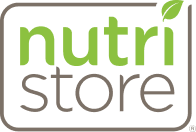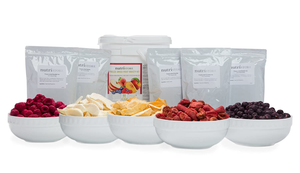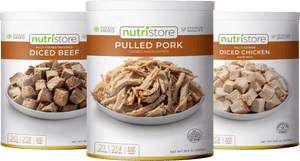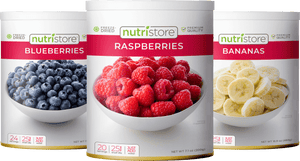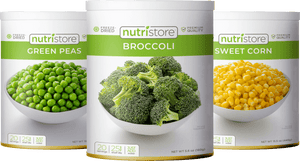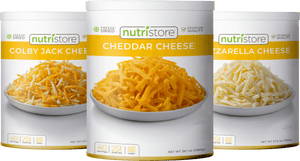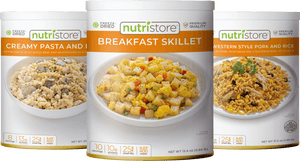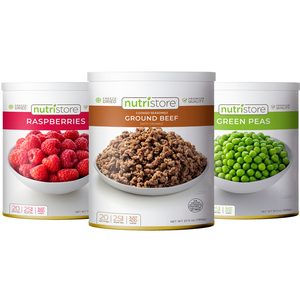7 Best Tips to Improve Your Emergency Food Storage Supply

Follow these simple steps to help make your long-term bulk survival food supply ready for any size emergency!
1. Make sure your emergency food ingredients are 100% Freeze Dried.
Freeze-drying has several crucial benefits which will improve any emergency food supply. Other emergency food brands often use dehydration or other preservation methods that do not produce long-lasting, premium ingredients. Freeze-drying provides the longest shelf-life of up to 25 years, while dehydrated or self-canned ingredients can only last a few years. The flash-freezing technique also locks in 97% of total nutrients and retains the color, shape, taste, and texture of freshly picked produce.
Learn more about freeze-drying here.
2. Store your emergency food in a cool, dark place with little light exposure.
The biggest worry when it comes to emergency storage is how to keep your food preserved for as long as possible, before and after it has been opened. The 4 factors that can reduce the shelf life of freeze-dried emergency food are:
1. Oxygen
2. Moisture
3. Light, and
4. Temperature
To maximize your emergency food’s shelf life, store in an area between 55-75 ºF that has little exposure to natural light, air, and moisture. This may be in a pantry, basement, or cupboard. One customer even found that under their bed made for a perfect emergency storage space
For more details on the shelf-life of freeze-dried food, read more here.
3. Add foods your family will actually want to eat to your emergency supply
One of the biggest mistakes preppers make is selecting cheap, unappetizing survival food that your family members would not be interested in eating in times of emergency. To ensure a positive emergency food experience, taste-test a variety of ingredients and meals before adding a large supply. If something comes up during the week and you don’t have time to cook a full homemade meal, try grabbing a meal or ingredient from your emergency food supply and have your family test it out! If it passes the family taste test, then it might be a good idea to start building out more in bulk.
4. Keep your Food Supply organized in a FIFO system so older items are in front.
No one likes breaking into your emergency food and noticing that it has expired and is now useless. “FIFO” is a food organization term that stands for “First in, First out”. One helpful tip for avoiding expired products is to use a FIFO-oriented organization system, so you are correctly cycling through your food supply and using the product that has been in storage the longest.
Check out our selection of rotating FIFO Can Trackers for more info!
5. Choose emergency food that is high in nutritional value.
Nutrition is key, especially in times of survival. Several long-term food brands often use unhealthy fillers and additives to try and increase shelf life. Make sure you choose emergency foods that use premium ingredients that are high in protein and calories, but low in unhealthy fats, sodium, and sugars. By prioritizing nutrition-focused foods in your emergency food storage, you will feel better prepared and confident when serving your family in times of need.
6. Keep your Food Supply stocked with a variety of different food categories.
A well-balanced supply of food groups should be just as much a part of your emergency prepping as in your everyday eating. An emergency food supply should include a variety of different ingredients from freeze-dried fruits and veggies, to meats and cheeses. These types of ingredients are also extremely versatile and can be added to any recipe and help enhance other ready-to-eat meal options. Check out Nutristore's wide variety of ingredients-
7. Find emergency food that is easy to prepare and ready in minutes
When emergency strikes, there may not be much time to react. To avoid added stress and resources, you should choose emergency food that is simple and quick to prepare. If water is required, then look for foods where less water is needed to help save on weight and hydration. One idea might be to break open your food supply and familiarize yourself with the process of preparing just-add-water meals and ingredients.
Comments (3)
perfect
I would like to know, if these foods are Organic, non GMO.. free of pesticides and fertilizers
So excited about finding your sight. Ordered sausage crumbles and mozzarella cheese. Was hoping to find out when the other cheeses will be available. And why no egg or milk products?
Leave a Comment
You May Also Like

Is Freeze Dried Food the Same as Dehydrated Food?
Knowing and understanding the difference between Freeze-drying and Dehydration helps when deciding which shelf-stable products are best to store and serve for your family.

7 Best Tips to Improve Your Emergency Food Storage Supply
Follow these 7 simple steps to help make your long-term bulk survival food supply ready for any size emergency!
